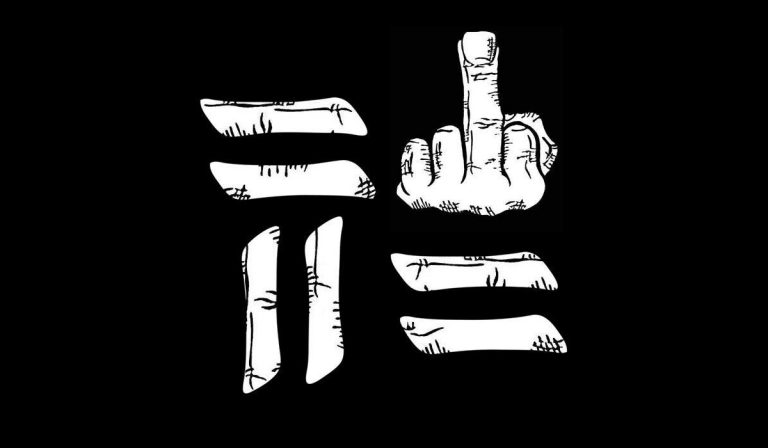When I tallied the top Parkour stories of the decade the one that came in 10th place was controversy. Now I don’t like controversy, but there sure was a lot of it in the Parkour world in the 2010s. As crazy as some of it was, looking back it was clearly the growing pains of a new sport and industry. In that regard, I think it’s worth looking back on the biggest controversies that reverberated through the Parkour world over the last 10 years.
From my perspective, there were 5 controversies in the 2010s that stood out most prominently in the international Parkour community. These controversies are not only relevant because of the prominence they had in the Parkour world, they’re also relevant because in many ways they stand as mile posts of progress as they give historical testament to the biggest issues, discussion points, and paradigms shifts that the Parkour community shifted through over the last 10 years.
In historical order…
#1. F*ck Urban Freeflow
Urban Freeflow (UF) was one of the first, if not THE first, real Parkour based brand in the world. It was founded in England in 2003 by Paul “EZ” Corkey (known as EZ) and his business partner Mark Toorock (who split from the brand in 2005 and launched American Parkour). Everyone who started Parkour between 2003 and 2010 was either involved with UF or was inspired by them in one way or another. UF push the Parkour/Freerunning discipline ahead in some amazing ways, and the iconic “Glyph” logo is still immediately recognizable by all Traceurs who were a part of the scene back then.

So how and where did things turn south for Urban Freeflow? With so much support, where did the controversy come from? Well, honestly I don’t quite understand it fully, because I’m from the USA, and I was a bit removed from ground zero so to speak. But from my viewpoint across the pond there were a few main things that sparked the controversy:
- UF’s steps to commercialize Parkour through competitions, merchandise, and business in general was in contrast to the non-profit vision that a majority of the PKFR world held at this time
- The strong marketing stance that EZ took with UF was off-putting and to many in the community. Using titles as “The Official Worldwide Freerun/Parkour Network,” and, “World’s premier parkour and freerunning organisation” were not well received.
- Many were jealous of UF’s success. UF had the largest Parkour channel on YouTube and Facebook, and claimed more than 1 million website subscribers.
- EZ himself was pretty disagreeable. One time EZ wrote me an unsolicited email and flat out called called me a liar, and I’m sure that type of bluntness was not an isolated incident, soooo yah he didn’t beat around the bush on things lol.
Looking back on it now, most of that seems pretty shallow, but trust me – people HATED Urban Freeflow for a while. People who lived in the UK at this time will know more for sure, so I’ll conclude my summary with this video. The video description has some great insight as well.
So what has happened to UF since this controversy? Well the information is kind of sparse, but I’ll share what I know and perhaps others can chime in as well. EZ originally changed his focus from PKFR to lifting/training, and subsequently he transitioned the Urban Freeflow YouTube to focus on that. That didn’t seem to go so well as the Glyphmedia YouTube is no longer active and all lifting videos have been removed.
As far as the brand goes, I heard that EZ sold or passed on the intellectual property. According to the wikipedia page, “four German athletes took over the brand,” and I think Giles Longley and Jason Paul were a part of that. That group went on to create a new UF site with some great articles, however, as of today UrbanFreeflow.com is no longer online and the social media appears to have been abandoned for almost 3 years. If you want to know more, ask Giles, because that’s all I got.
In my research, I also found this article from MUV Magazine. Apparently in 2016, EZ was sentenced to 2 years in prison.
Not every company or brand lasts forever. Urban Freeflow sure didn’t. But maybe in the 2020’s it can make a resurrection. Time will tell.

#2. Take Flight Sucks!
I am actually the founder and owner of Take Flight, so I’ll try to be as neutral as I can. I’ll speak about Take Flight in the 3rd person.
Take Flight is a Parkour brand founded in 2009. It started with a focus on t-shirts and quickly grew to have the most extensive clothing line in the Parkour world. In 2014 the company branched out by launching its first Parkour shoe, and from 2010-2015 the company sold more clothing than any other Parkour brand in the world. During this time Take Flight sponsored some of the most iconic and influential Parkour pros of the generation including Pasha Petkuns, Shaun Wood, Toby Segar, Stanislavs Lazden, Pedro Salgado, Luis Alkmim, Joey Adrian, the Tapp Bros, and the master and founder himself David Belle. The company even launched a David Belle brand clothing line.

The company found commercial success, but things weren’t always rosy for Take Flight. From early on controversy welled up around the brand, and it followed them for years. There were a myriad of events that led to a negative reaction in the Parkour world, the most prominent of which were:
- Take Flight was a business. In the early 2010’s a large percentage of the PKFR world was still against people making money from Parkour, and Take Flight took a lot of flack for being a business.
- Strong marketing stances. Take Flight first called themselves, “The World’s First Parkour Clothing Company,” then in 2009 they changed their slogan to “The Official Clothing of Parkour,” and when they launched their first Parkour shoe in 2014 they dubbed it, “The Greatest Parkour Shoe of All Time.” These strong marketing stances did not sit well with the PKFR world as they seemed overreaching and lacking in humility.
- People found out that Take Flight had purchased more than 100 Parkour-related domain names including things like ParkourTees.com, ParkourPants.com, DameDuLac.com. This caused a lot of assumptions, accusations, and fears about their plans and vision for Parkour.
- People found out that Dunlap had registered domain names of Parkour athletes and influencers including DanielIlabaca.com, MarkToorock.com, and TimShieff.com. This further drove the negative perception and questions about the motives behind the company.
- There was a longstanding rumor that Take Flight copyrighted Parkour. This issue brought so much concern to the Parkour world that it was even briefly brought up in the pro discussion at the first even Tempest Pro Takeover in 2013. (this rumor was factually false)
- When David Belle launched his social media in 2011, his channels supported Take Flight, and a rumor quickly swept the Parkour world that Dunlap, was impersonating David Belle in an attempt to market Take Flight. This drove Dunlap and Take Flight’s reputation even further downhill. (this rumor was factually false)
- In 2014, Kie Willis made a “Kie Dishes the Dirt”* episode where he accused Dunlap & Take Flight of multiple nefarious things including stealing clothing design from other Parkour teams. This video was followed shortly after by a video from Tim Shieff that echoed the same sentiments. These two videos went viral and fueled the height of hte hate against Take Flight. (Both of these videos have since been removed from YouTube by Willis and Shieff)
Dunlap stood to his ground and routinely countered the rumors and defended his actions in interviews, videos, and blog posts, but the facts stand that these things led to a lot of Traceurs truly hating Take Flight. Things went so far that sponsored Traceurs were pressured to leave the brand, some people burned Take Flight gear, and many prominent Traceurs, gyms, and brands refused to work with the company and encouraged others to follow suit. A site called TakeFlightSucks.com was even created in opposition to the brand.
So where is Take Flight now? Well, in spite of the controversy, Take Flight has kept doing its thing. The company still makes Parkour gear and now their focus is on Parkour shoes. They launched their 3rd Parkour shoe in 2018 which has been well received by Traceurs around the world, and it seems that, at least from my perspective, that the drama has subsided, and the company has found a newfound respect in the community. But again, I’m on the inside so what do I know.

#3. Parkour Competitions were a no-no
What are some of the most exciting Parkour events in the world every year? Yup, you got it – Parkour competitions. The Red Bull Art of Motion is seen as the most prestigious, and that is followed closely by the Origins Parkour Pro and many regional and local Parkour competitions that feed into these events and also exist on their own. But there’s something you have to understand about all these competitions: 10 years ago, at the beginning of the decade, most of the Parkour world was against them!
You’re going to have to take my word for it, because there wasn’t a single event or focal point that I can explain. What I can explain is that at the start of 2010 Parkour was seen as non-competitive, and most of the world’s Traceurs seemed to want it to stay this way. The belief was that competitions weren’t a part of Parkour, and the fear was that competitions would cause Parkour to lose its spirit as Traceurs began focusing on being better than each other.
Here is an interesting article I found on this topic. It’s from Naim Linconsolable, a highly respected Traceur from France. In this article he explains 5 reasons not to participate in any Parkour/Freerunning competition. He published this in April, 2012, and I think it accurately reflects the prominent cultural paradigm of the time in the Parkour world.
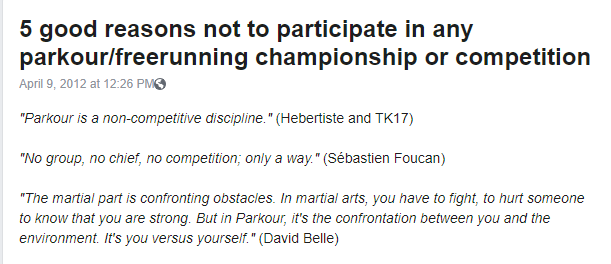
I must say, I was definitely anti-competition in the early 2010’s, but I have since been won over (more or less), and I think virtually every Traceur now has been as well.
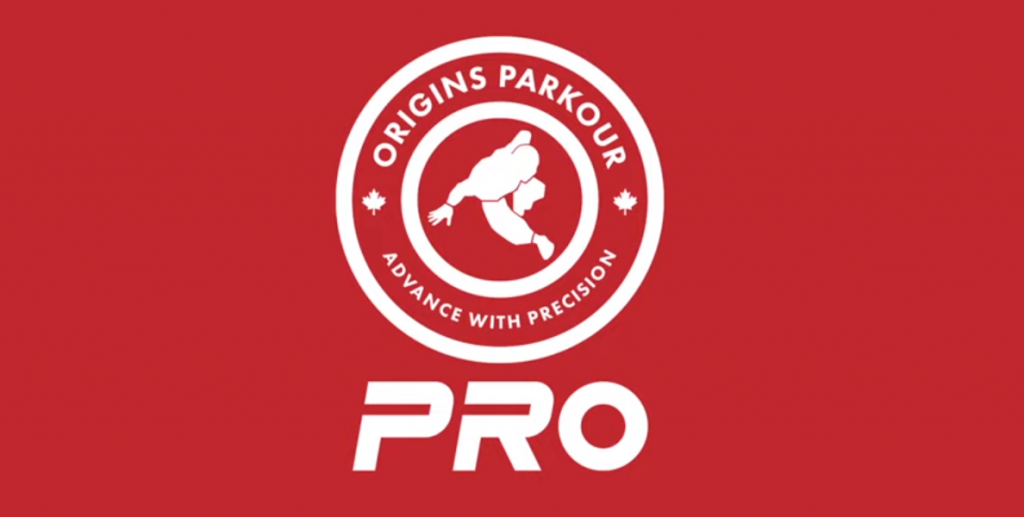
#4. WHAT THE FIG?!?!
The most recent global controversy in the Parkour world revolves around the International Gymnastic Federation, known as FIG. FIG has recently started running their own Parkour competitions, and they seem to be doing so in pursuit of a larger goal of making Parkour a subsidiary discipline under their organizational umbrella.
For obvious reasons, this action doesn’t sit well with the Parkour world. It’s seen by most as a power play and money grab from a big organization that has no connection or affiliation with the Parkour community.
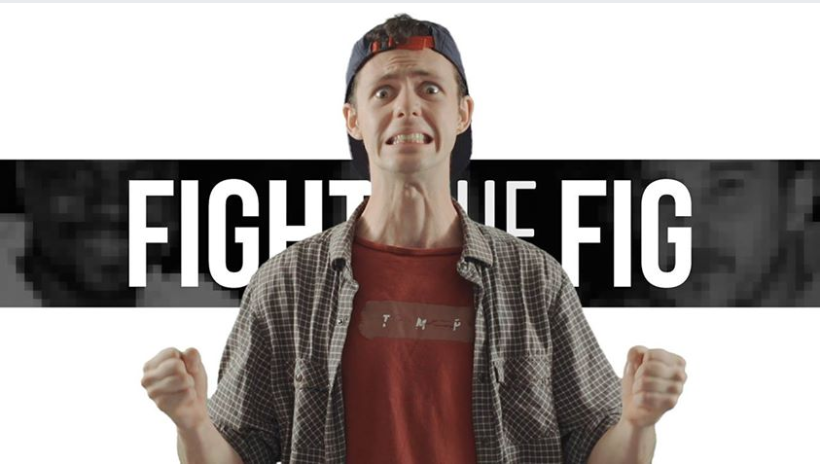
I’ve been somewhat involved in the discussion for a while, and from my perspective, although I am on the side of Parkour, it’s actually quite a complicated matter. One’s opinion on the issue can very well tilt either way based on a myriad of factors. Suffice it to say, although there could be potential benefits for a large organization such as FIG helping Parkour reach more people, I think everyone in the Parkour world agrees, that at least in principle no current Traceur wants to be forced under the umbrella of another organization and be forced to pay their dues etc especially when we have so many great Parkour organization rising up and doing great things for Parkour from within the community.
Many big pros including Pasha Petkuns (via his Instagram) have voiced support of FIG and their events, so the issue is by no means dogmatic with people lining up on both sides. Time will definitely be the thing that sorts this one out. In the meantime, click HERE to read are a few articles from MUV Mag about the situation. There is also a great article below by Andy Bull that is worth a read.
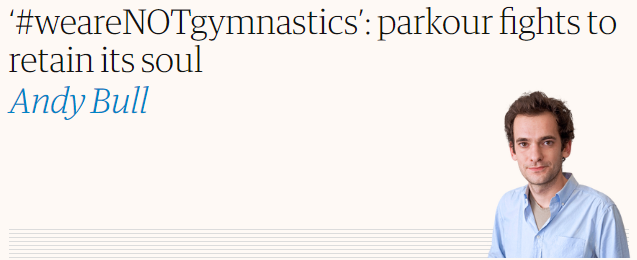
#5. Awful judging of Freerunning competitions
The last controversy is the most recent one, and it’s little in comparison to the other 4, but I definitely see it playing out in the coming years so I thought it worth bringing up. Recently, and in response mostly to the Art of Motion online qualifier event, there has been some controversy on the judging that happens at Freerunning events. The “how” isn’t entirely clear to anyone, and a discussion about it has begun, instigated perhaps by Bob Reese.
If you’ve been a fan of the Art of Motion events that have taken place over the decade, then surely you saw judging at times that made absolutely no sense. Superior runs were scored down, and weak runs were scored up on multiple occasions. But what’s most frustrating about these disagreements is that no one articulated how they got the scores they did! One could say this happens in some way in every sport where the fan perception doesn’t equal the judges scores, but in the PKFR world we at least aspire to be the best we can be and the current system is clearly not it.
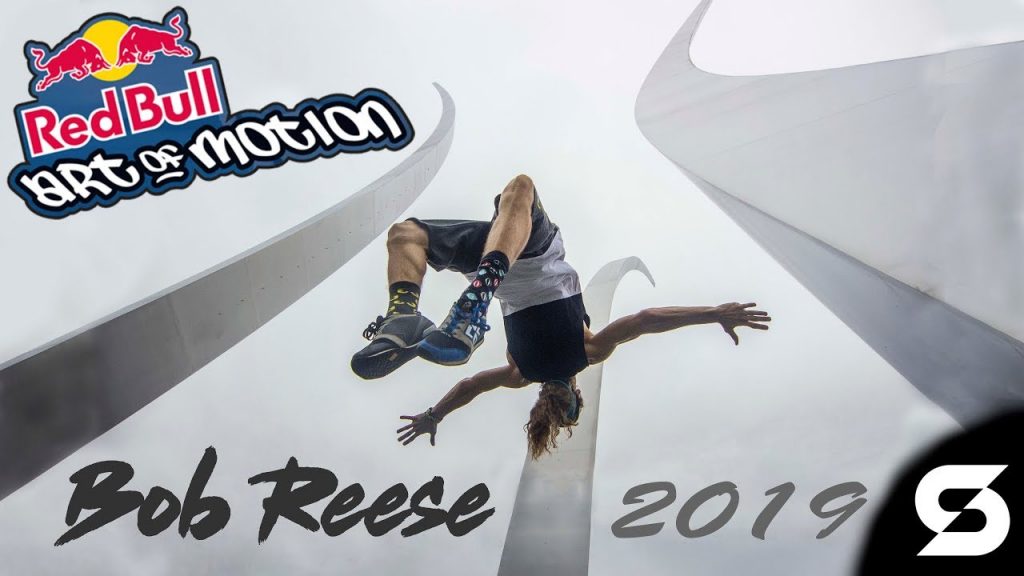
Alas, the judging structure is an issue that is in debate, and although this “controversy” may have not really gotten any larger than a few people being upset that they didn’t get an invite to the AOM, it’s something that is on the minds of many and a discussion is ongoing. The result in the years to come will surely be a much better scoring system that has big effects on the PKFR events moving ahead..
Here is a video on the topic that I made in response to the ideas put forth by Bob Reese, Julien Williams, and Joey Adrian. It speaks to some of the bigger ideas floating around in regards to judging freestyle comps.
As I see it, those are the 5 biggest Parkour controversies of the decade. Do you agree? Disagree? I’d love to hear your thoughts. One thing is for sure, we haven’t seen the end of controversy in the Parkour world. Controversy is practically a human need for one reason or another, and between growing financial opportunity, growing personalities, growing competition, and all the rest, there’s bound to be more disagreements in the Parkour world in the coming decade. The controversies from the 2010’s led to a lot of growth, but they also led to a lot of division. My hope is simply that we can at least learn from the past and not make the same mistakes that we have. Regardless of what comes our way, I believe that through grounded thinking, open conversation, and kindness we can overcome any controversy and continue driving towards a better Parkour world.
Stay tuned for Parkour story #9 of the decade. And if you enjoyed this article please share it on on your Facebook, Twitter, or other social media.

